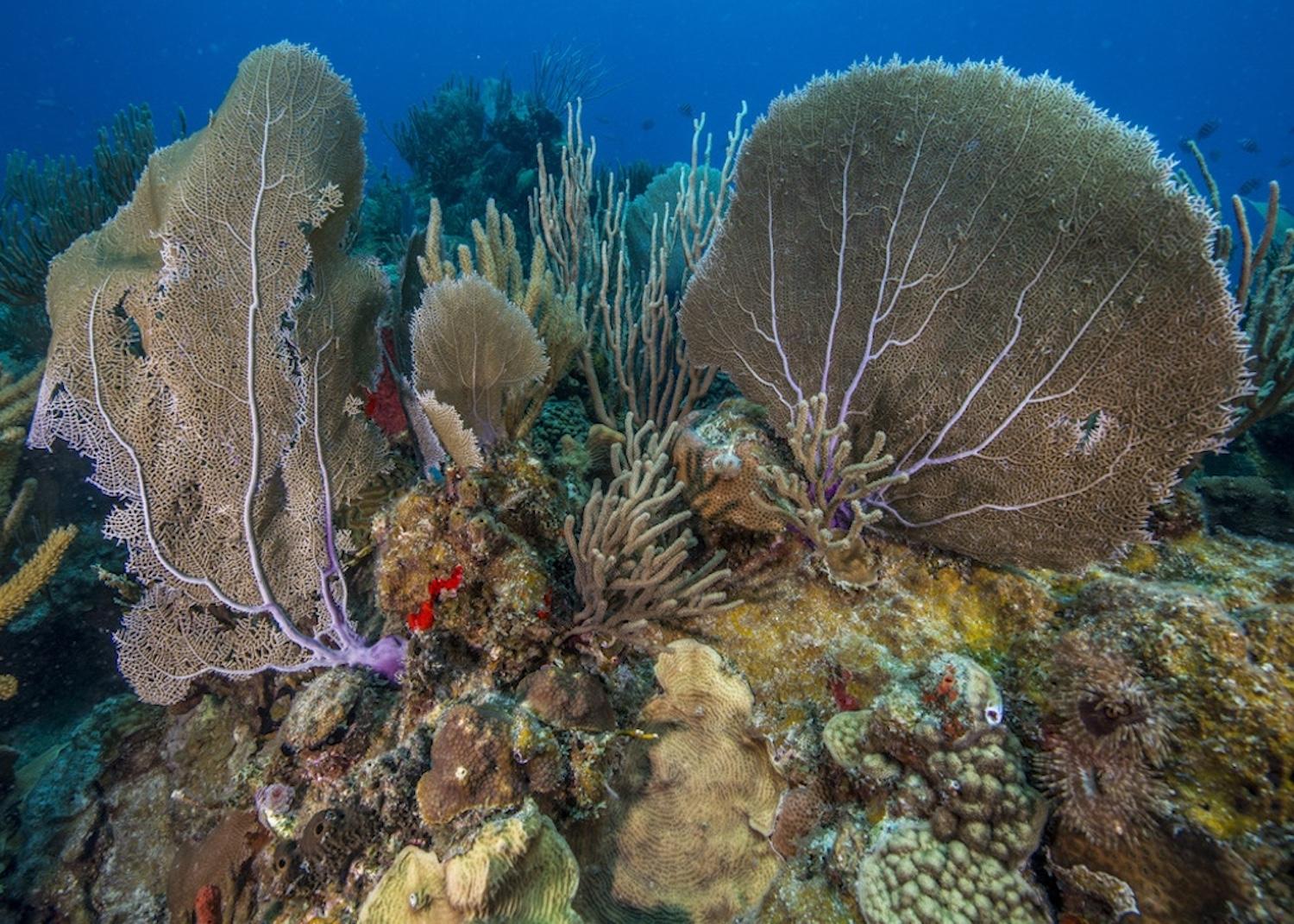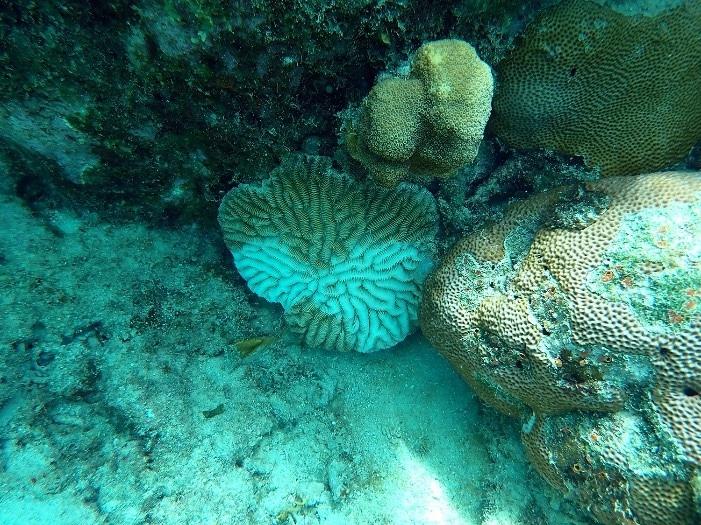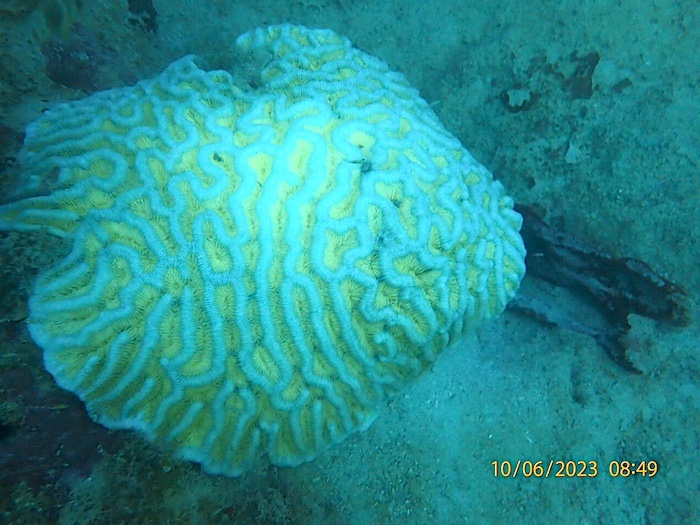"Global Mass Coral Bleaching And Mortality Event" Expected To Hit Caribbean Parks Hard
By Kurt Repanshek
Editor's note: This updates with additional comment from NOAA scientists; Ove Hoegh-Guldberg, the paper's lead author; and Sophie Dove, a co-author.
Sparkling white beaches rimmed by tangles of Tyre palms, seagrapes, and gumbo limbo trees. Warm Caribbean waters tinted turquoise and flecked with darting blue tangs, schools of yellow sergeant majors, and luminescent green parrot fish. Purple reef fans swaying in the currents above their brain, staghorn, and elkhorn corals. These make Virgin Islands National Park a tropical paradise.
Sadly, the idyllic underwater imagery has lost much of its vibrance, dulling to a dead, chalky, submarine seascape, and the outlook is not optimistic.
That's because ocean warming is leading to "a global mass coral bleaching and mortality event over the next 12 to 24 months," with untold damage being done to coral reefs within national parks in the Caribbean, according to research published Thursday in Science.
"The persistence of coral reefs beyond the next few decades remains in serious jeopardy," the paper states. "Rising sea temperatures, coupled with other stressors such as ocean acidification and pollution, have severely weakened the resilience of coral reefs. Changes are insidious yet fundamental."

A portion of a healthy coral reef in the Virgin Islands/NPS file photo from before recent bleaching events.
Heat Compounding Disease
Already, the corals around Virgin Islands National Park, Buck Island Reef National Monument, Virgin Islands Coral Reef National Monument, and Salt River Bay National Historical Park and Ecological Preserve have been hit hard by stony coral tissue loss disease, which the Traveler reported on two years ago. It's an infectious, water-borne disease that impacts hard coral species and damages entire reefs. The warming oceans are exacerbating that disease, and then some.
Bleaching is the result of warmer-than-usual water temperatures killing off the corals' resident microbial organisms. Water temperatures this past summer left many coral reefs around the marine parks bright white. In late September, a water temperature of 87.3.° Fahrenheit (30.7° C) was recorded at two locations of the national park, the warmest recorded in more than 30 years of monitoring, Jeff Miller, a National Park Service fisheries biologist who, before he retired in 2021, worked with the South Florida/Caribbean Inventory and Monitoring Network on developing a coral and fisheries monitoring program, said Wednesday during a phone call from St. Thomas, Virgin Islands.

This nearly fully bleached brain coral was photographed in early October/Courtesy of Jeff Miller
According to the scientist, Caribbean waters began warming as normal in April and May, but then turned hotter than normal through the summer and into October.
"The 'bleaching threshold' temperature for corals in the Virgin Islands is approximately 29.5C [85.1° F]," he said. "So the temperature far exceeded what can be considered the critical maximum for corals. It was well out of their comfort zone."
Some are recovering in the seasonal cooling of waters — "We saw most all corals bleached by mid- to late-September, and in November we saw corals then begin to recolor [as some recovered their microbial organisms]," said Miller — but experts worry that they nevertheless are weak. Under worst-case scenarios, reefs don't recover and instead are broken down and eroded away, taking with them "the vital habitat that many coral reef-associated species depend on ... leading to ecosystem collapse," the new research states.

Corals infected with stony coral tissue disease/USGS, Caroline Rogers file
In Park Service research from 2005-2007 following a large episode of Caribbean coral bleaching, the NPS network found that it's "when recovering from a big bleaching episode that the corals became extremely vulnerable to mortality from coral disease. So we are very concerned that these corals may be in a weakened state and more vulnerable to coral disease," said Miller.
The research published Thursday, Coral Reefs In Peril In A Record-Breaking Year, noted that NPS research.
"Outbreaks of coral disease have occurred for months to years after all prior mass bleaching events in the wider Caribbean, which has often led to higher rates of mortality than the initial heat stress," reads a section of the paper written by Professor Ove Hoegh-Guldberg from Queensland University in Australia and eight colleagues.
The paper warns that ocean-warming "marine heatwaves" that are "occurring throughout the ... wider Caribbean will likely be the precursor to a global mass coral bleaching and mortality event over the next 12 to 24 months as the El Niño phase of [the El Niño-Southern Oscillation] continues."
“Nearly all coral reef regions in the wider Caribbean, including Florida, were exposed to more than double the amount of heat stress that is expected to elicit mortality,” said Derek Manzello, Ph.D., coordinator of NOAA’s Coral Reef Watch program in College Park, Maryland. “The full ecological impacts of this event will not be fully realized for months-to-years, but preliminary reports have been alarming, as high levels of mortality in staghorn and elkhorn corals have already been reported in Florida, Puerto Rico and Mexico.”
An Increasingly Familiar Problem
Coral bleaching is not a new phenomenon.
During the summer of 2005, when sea temperatures approached 90 degrees, there was widespread coral bleaching in the Virgin Islands — more than 90 percent of the coral cover was affected, according to a U.S. Geological Survey report. A return to cooler temperatures helped some of the corals recover, but many others died.
The effects of bleaching and disease on coral reefs in the USVI (U.S. Virgin Islands) have been profound, and no other stressors have caused greater or more rapid coral cover declines on these reefs. These and other studies show that losses were similar for reefs inside and outside marine protected areas, including marine reserves. The anticipated benefits (for example, replenishment of fish and corals) from marine reserves (Virgin Islands Coral Reef National Monument and Buck Island Reef National Monument) established in the USVI in 2001 could be undermined by these significant declines in coral cover. No measurable recovery has been documented to date. The recovery of USVI coral reefs will depend on the severity and frequency of expected future bleaching and disease events. -- USGS
Miller, who now volunteers for the South Florida/Caribbean monitoring team, said the most recent bleaching episode was part of a 1-2-3 punch that has staggered the reefs:
- In September 2017, two Category 5 hurricanes, Irma and Maria, arrived within two weeks to pummel the Virgin Islands.
- Next, a "real bad disease" — stony coral tissue disease — struck and caused considerable coral mortality. "Any of the coral that survived the hurricanes is now in an environment that's been ravaged by this coral disease," Miller said. "There's just no other way to say it — It may cause the local extirpation of a couple species."
- The third punch is the latest period of coral bleaching that began late this past summer and is expected to worsen in the coming months.
Even given that corals in different geography have different tolerance for warm waters — and shallow-water corals can withstand hotter temperatures than deep-water corals — "This summer was so warm, it just blew everything out of the water," Miller said.
Sophie Dove, a co-author on the paper and colleague of Hoegh-Guldberg at Queensland University, where she is a reef ecologist, said “[C]orals are literally dying before they even have a chance to bleach at. Of course, this amplifies the seriousness of the escalating change on our precious coral reefs.”
A Double Whammy?
In his paper, Hoegh-Guldberg noted that historic heat stress this past summer for many Caribbean reefs began up to two months earlier than usual and is expected to last longer than normally seen.
"[T]he present El Niño conditions are predicted to persist for at least the first quarter of 2024," the paper said, adding that, "[S]ince 1950, an El Niño state that is present for the last 6 months of a given year and for at least 3 months in the following year has occurred seven times. In every instance except one, the second year was the warmer of the two. ... Since 1997, every instance of these El Niño pairs led to a global mass coral bleaching and mortality event."
Hoegh-Guldberg and his colleagues warn that "swift action needs to be taken to safeguard 25 percent of ocean biodiversity and the future of more than half-a-billion worldwide who depend on coral reefs."
Despite the paper's ominous tone, Miller isn't about to write off the reefs.
"I really try to emphasize that these things make it seem hopeless, and if that is the case then we have lost," he said. "It isn't hopeless. In fact, it is more imperative now that people become advocates for coral reefs and, as this Science paper discusses, deal with the factors influencing climate change.
"The science behind all this is the driver for funding the parks at modern levels," he continued. "Funding them so they can staff law enforcement divisions that can do resource protection. Funding parks so they can staff resource management divisions so their work can be done to fulfill the NPS mission: to preserve unimpaired the natural and cultural resources for the use and enjoyment of this and future generations. Current park funding and staff have no hope of accomplishing this mission."



 Support Essential Coverage of Essential Places
Support Essential Coverage of Essential Places







Comments
Knowing that sunscreen chemicals can affect marine life: Green Algae: Can impair growth and photosynthesis. Coral: Accumulates in tissues. Can induce bleaching, damage DNA, deform young, and even kill, I am surprise that you do not mention any of this in your Article espacially since the USVI have passed a law ( articel 8185) banning all chemicals susncreen in the USVI, you may want to consider and re-post in this article.